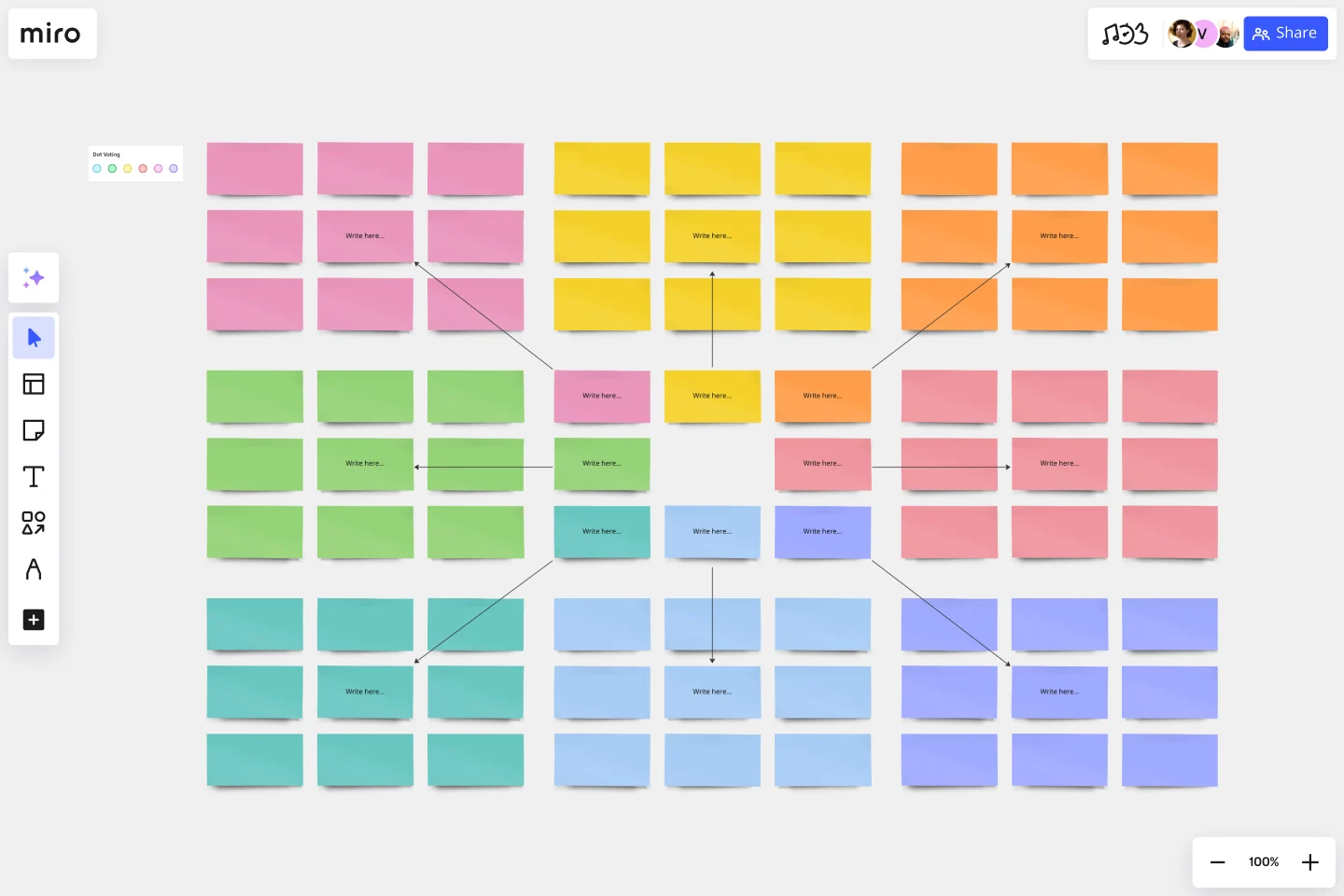Mandala Chart Template
Create a plan to achieve your goals with a mandala chart template. Visualize all the necessary elements to achieve your objectives.
About the Mandala Chart Template
The mandala chart template helps elevate your brainstorming, planning, and goal-setting. It offers a unique lens to view, understand, and organize your ideas, bridging abstract concepts and concrete action plans.
The template consists of a chart that divides a large theme or concept into eight sub-themes, allowing for a comprehensive understanding of topics at different levels of granularity. The chart visually encompasses the complex relationships between the core theme and sub-themes, promoting clarity and coherence.
How to use the mandala chart template
Using the mandala chart template is easy. Follow these steps to begin filling it in:
Write the goal or theme you want to explore at the center of the template.
Fill in the eight sticky notes around the main idea or objective, writing down what is needed to achieve this goal.
Divide the eight elements from the previous step into actionable plans. Write them down in stickies.
Share your mandala chart with others. Ask for instant feedback directly on your board.
Monitor and follow-up. As soon as you start making progress, update the mandala chart.
Why use a mandala chart template?
Filling in a mandala chart offers a holistic view of a topic or problem, making it possible to see the big picture without losing sight of the details. Some of the benefits of using a mandala chart template include:
Efficiency and speed: By using a pre-made template, you can craft mandala charts in a fraction of the time it would usually take.
Organized visualization: Systematically visualize and organize ideas, ensuring no crucial point is left out. You can also add images, links, or other artifacts to your board to supplement the mandala chart.
Holistic understanding: By dividing a central theme into sub-themes, you can better grasp the bigger picture and the interconnectedness of ideas.
Actionable planning: Beyond mere visualization, the mandala chart template guides planning actions that will lead to success.
Collaboration and sharing: The design is primed for sharing, ensuring you can easily exchange ideas with colleagues or stakeholders.
What's the primary purpose of a mandala chart?
Mandala charts are tools to understand and visualize the relationships between a central theme and its sub-themes, helping users see the detailed components and the broader overview of a topic.
Can I customize the mandala chart template to fit my needs?
Yes! The template is designed for flexibility, ensuring you can adjust it to reflect your unique needs.
Is the mandala chart only for brainstorming?
While it's an excellent tool for brainstorming, its uses extend to planning, organizing, and even presenting ideas. It's a versatile tool fitting multiple phases of a project.
How does the mandala chart aid in collaboration?
The design of the mandala chart encourages sharing and collaboration. By clearly representing ideas, all collaborators are on the same page, streamlining discussions and collective decision-making.
Get started with this template right now.
Service Blueprint by Hyperact
Works best for:
Research & Design
The Service Blueprint template is perfect for visualizing the orchestration of service components. It maps out frontstage and backstage elements, helping you analyze and enhance customer experiences. Use this template to align teams, identify pain points, and streamline processes, ensuring a seamless service delivery. It's ideal for creating a shared understanding of service dynamics among stakeholders and collaborators.
UML Sequence Deployment Pipeline Template
Works best for:
UML
The UML Sequence Deployment Pipeline Template in Miro visually maps the sequence of steps in an automated deployment pipeline, helping teams in software development and deployment. It helps identify bottlenecks, standardizes the deployment process, and facilitates new member onboarding for continuous improvement.
ERD Supply Chain Management System Template
Works best for:
ERD
The ERD Supply Chain Management System Template streamlines and optimizes supply chain operations. It serves as a visual support that helps businesses understand and manage the complex relationships between different entities within their supply chain, such as suppliers, products, inventory, orders, and shipments. By providing a clear visualization of these relationships, the template enables users to identify inefficiencies and areas for improvement, facilitating strategic decision-making.
Workday Calendar - Timeline 2024
Works best for:
Planning, Timeline
The Workday Calendar Timeline 2024 template is ideal for planning your work year. It helps you organize work schedules, track important deadlines, and plan for holidays and events. This template ensures you stay productive and on top of your work commitments.
Calendar 2024 - a Year timeline
Works best for:
Strategy, Planning
The Calendar 2024 a year Timeline template is perfect for planning and organizing your year. It helps you schedule important dates, track annual goals, and stay on top of deadlines. This template ensures you have a clear overview of your year ahead.
Work Breakdown Structure Template
Works best for:
Project Management, Mapping, Workflows
A work breakdown is a project management tool that lays out everything you must accomplish to complete a project. It organizes these tasks into multiple levels and displays each element graphically. Creating a work breakdown is a deliverable-based approach, meaning you’ll end up with a detailed project plan of the deliverables you must create to finish the job. Create a Work Breakdown Structure when you need to deconstruct your team's work into smaller, well-defined elements to make it more manageable.
